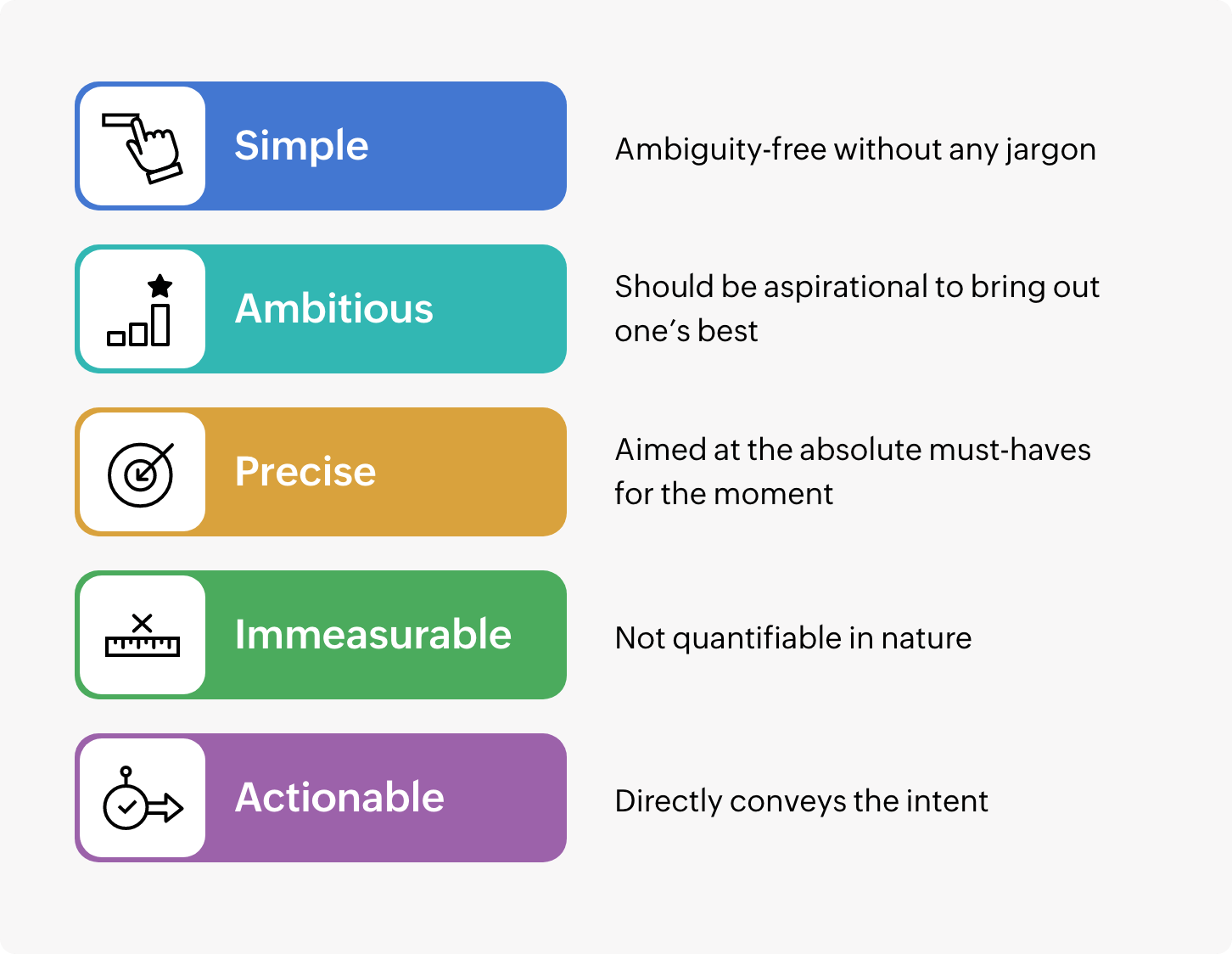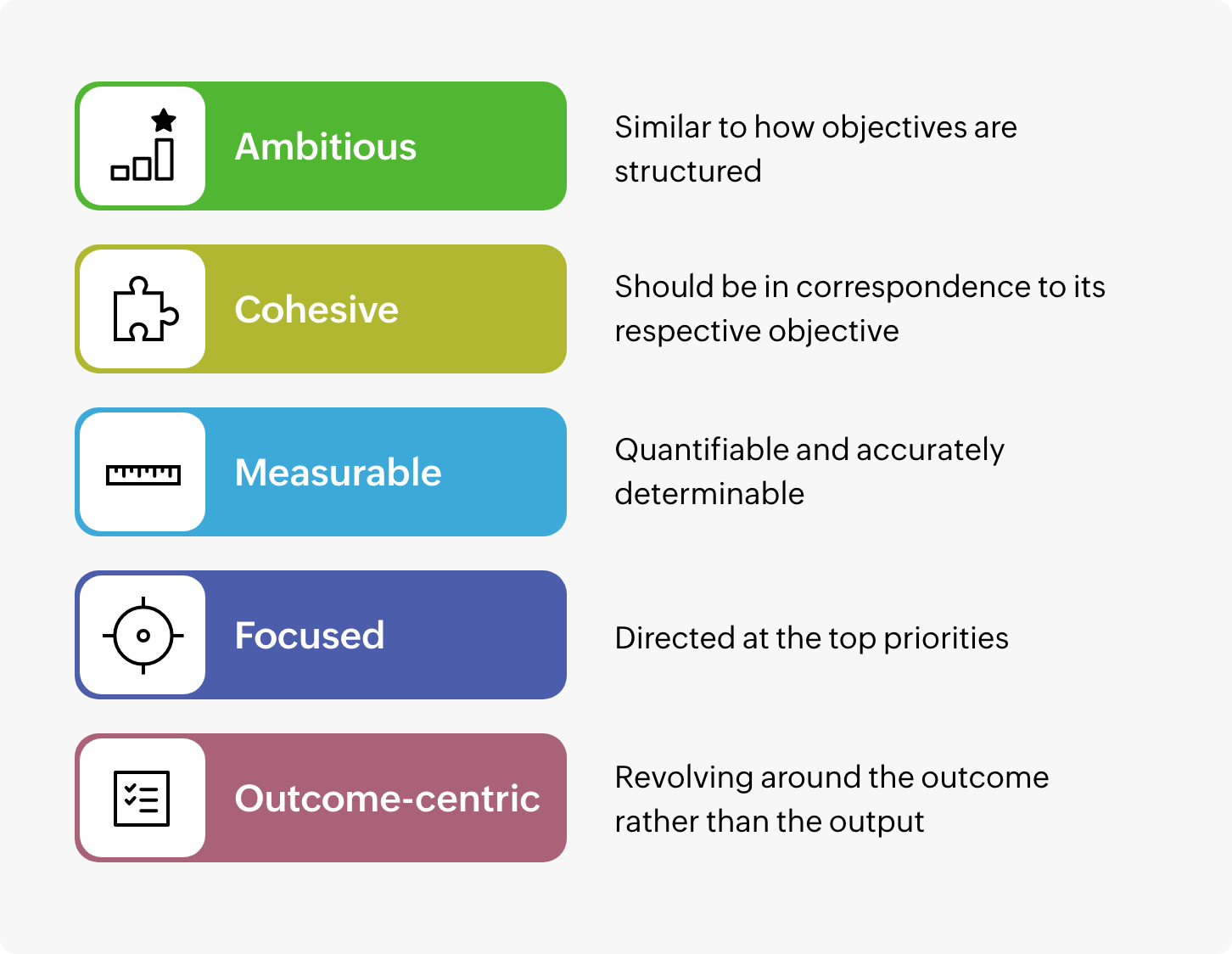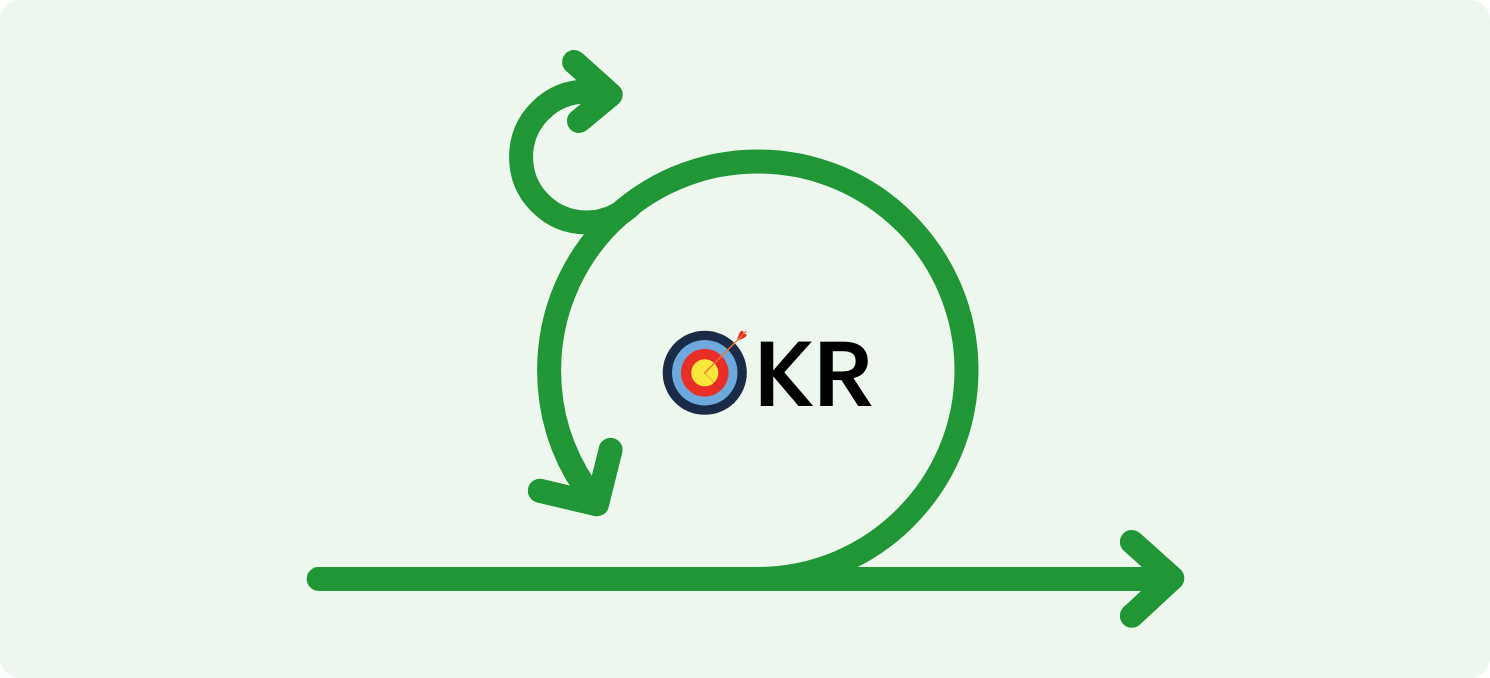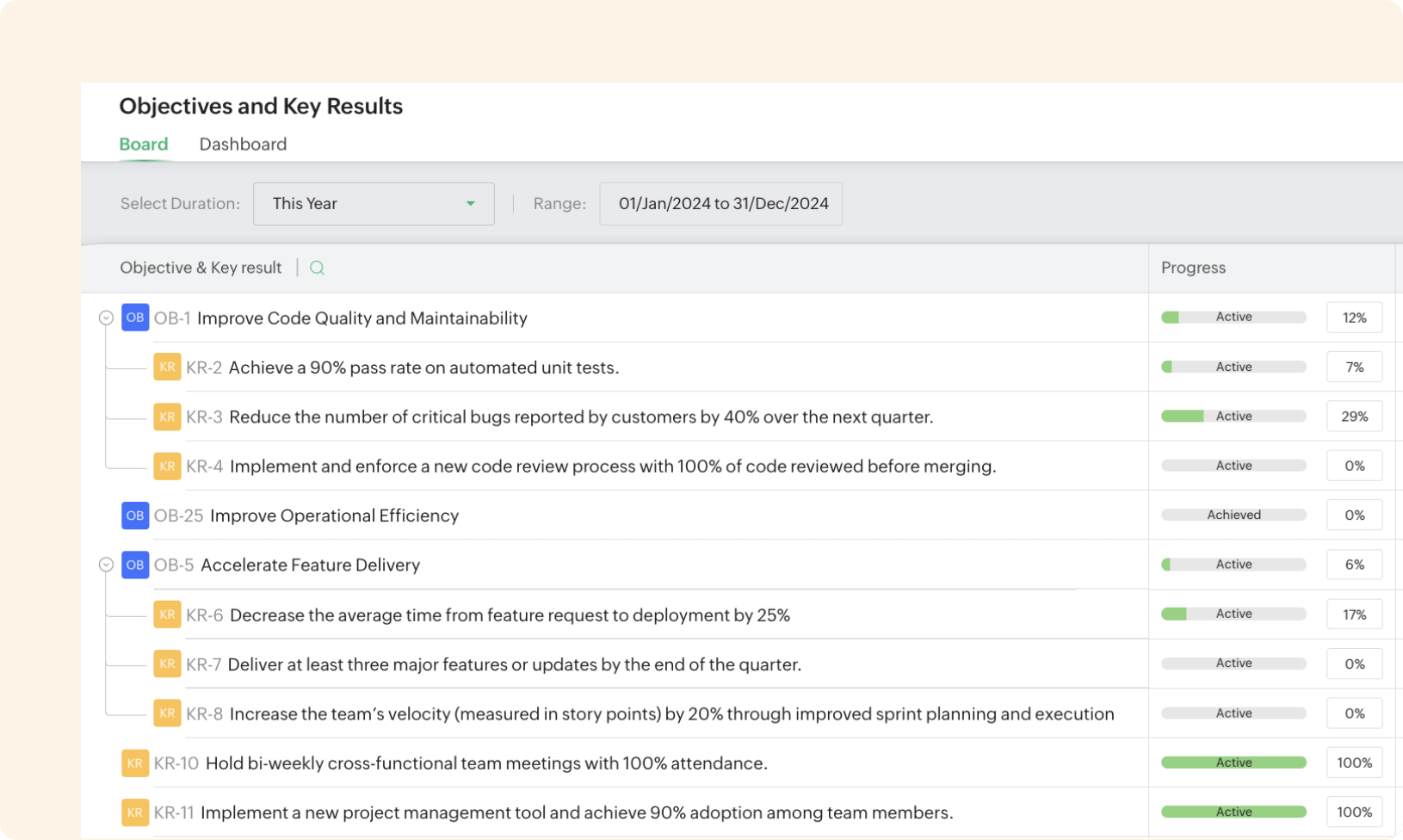History of OKR
The OKR framework evolved out of a concept known as Management by Objectives (MBO), established by Peter Drucker in 1954. In the 1970s, Andrew Grove, one of the most pioneering CEOs in the tech industry, conceptualized IMBO. He retained the core essence of MBO and implemented various adaptations to make it more applicable in a fast-paced IT environment. A very important adaptation was the addition of the "key results" component, and thus came about the OKR framework as we know it today.
In 1999, John Doerr introduced OKR to Google's founders, Larry Page and Sergey Brin. Doerr had previously learned about OKR in a course conducted by Andrew Grove 24 years prior. Noticing Google's fortunes in the years to come, various technology-centric organizations such as LinkedIn, Microsoft, Uber, and GitLab also adopted the OKR framework to great success.
The meaning of OKR
OKR is an acronym for its two constituent components:
Objectives:
Clearly defined goals that the organization seeks to achieve. In simple terms, they correspond to the question of "What needs to be done?"
Key results:
A set of three to five measurable outcomes that indicate the progress of the objective that they are placed under. They correspond to "How do I know it is done?"
The standard template for defining OKRs is as follows:
I will [objective] as measured by [key result 1, key result 2...].
How to write OKRs
Despite seeming rather straightforward, conceptualizing effective OKRs is a lot tougher than it looks. To draft a good set of OKRs, you should adhere to certain key characteristics for both components, as discussed below.
Characteristics of a good objective

- Simple: It is in your best interest to ensure that the objectives are easily understood by everyone in the organization without ambiguity. Keep the language as simple as possible while completely avoiding technical lingo or jargon, unless they are well-known across the whole organization.
- Ambitious: One of the crucial changes brought forward by Andrew Grove while creating the OKR framework was removing the tie-up between objective completion and performance evaluation that existed in MBO. His idea was to encourage the pursuit of stretch goals that are meant to be challenging on purpose. This allows the people working on the goals to bring in their A-game without worrying too much about failure. However, you should not make your objectives excessively ambitious to the point that they become unrealistic.
- Precise: The focus of the objective should be directed at the absolute key priorities. OKR efforts should not be directed to objectives that are not of prime importance at that moment.
- Immeasurable: Generally, it is best to avoid numbers and metrics in the objective and save them for key results. While you can break this rule on rare occasions, including numbers in the objective tends to make it too specific and removes the "ambitious" aspect from it.
- Actionable: An objective should ideally start with a verb and should directly convey what the organization desires to achieve.
Characteristics of good key results

- Ambitious: Similar to how objectives are structured, key results should also be ambitious but not unrealistic.
- Cohesive: As key results map out the progress achieved under each objective, they have to be in full relevance to the objective they are classified under.
- Measurable: Unlike objectives, it is necessary for key results to be quantifiable, as they map out the progress of their objective. You should also ensure that accurate numbers corresponding to every key result can be properly tracked.
- Focused: There should be just three to five targeted key results under each objective. Too many key results make it harder to give priority to what is crucial. Fewer than three key results might not be sufficient to cover all the crucial outcomes necessary.
- Outcome-centric: Key results should revolve around the outcomes of initiatives rather than the initiatives themselves. Having them focusing directly on initiatives goes against the core OKR definition.
How to set up an OKR framework for your organization
Now that you've understood the principles of writing good OKR components, it is time to set up an OKR framework. OKRs can get challenging in terms of execution due to their innate qualities of being collaborative, flexible, and ambitious. By following these steps, you can create a robust OKR framework and smoothly integrate it into your business.

Step 1: Establish the organizational strategy
Before starting with the OKR framework, you need to review the organization's mission and vision. Next, determine which key areas require your focus for the upcoming period, such as growth, innovation, customer satisfaction, and new product development. The combination of these two creates a "strategy pair" that acts as the structural backbone for your OKRs. This is also the phase where you define the cadence or time period for running your OKR cycles. It can be weekly, monthly, or even yearly depending on the nature of your strategy pair.Step 2: Set the objectives
Follow the characteristics described in the previous section and define a set of qualitative and inspiring objectives. Direct your focus towards the critical objectives that can be classified under the strategy pairs identified in the previous step. Try to limit your objectives to three to five for each cycle to avoid resource crunches or focus dilution.Step 3: Associate key results
Under each objective, develop three to five key results that effectively map out the progress of each objective. An established way to identify key results is to apply the SMART framework to the process with an emphasis on the specific, measurable, and time-bound characteristics. Remember, key results should only indicate the progress of an objective. It should not revolve around what specific initiatives need to be performed to achieve that progress.- Pro tip: John Doerr places the ideal success rate for key results under the OKR framework as 70%. If you notice that you are achieving 90-100% completion on a consistent basis, you might want to make your outcomes more challenging.
Step 4: Cascade and align
Cascading is the process by which broader strategic goals are trickled down to department levels with narrowed focus. The leadership team generally decides what strategy pair should be worked on. This then flows down to the departmental levels first, and then down to team levels, where they are picked up by individual team members or small groups. As the goals flow downwards, their scope gets more and more defined within the special prowess of that division.For example, let's take a case where a software company has set a high-level objective of launching a new SaaS product and acquiring 20,000 users in their first year. This objective is cascaded down to different departments as illustrated below:
- Engineering objective: Develop and deliver a stable product before the launch date.
- Marketing objective: Generate awareness and drive demand for the new product.
- Sales objective: Drive pre-sales and preliminary subscriptions for the new product.
The last stage of cascading will happen among teams within each department:
Marketing objective: Generate awareness and drive demand for the new product.
- Content team objective: Educate the market through high-quality, top-of-the-funnel content.
- Social media team objective: Amplify the product launch story through company social channels.
At this stage, individual team members will take on the lowest and most defined level of responsibilities.
Step 5: Review and revise
Conduct regular review meetings at a unanimous cadence (weekly, bi-monthly, or monthly) to review your organization's progress with the OKRs. These meetings can be utilized to identify any road blocks and make changes if necessary. Keep in mind that OKRs can be adjusted mid-cycle and aren't meant to be rigid throughout the process. This is how you ensure that the OKRs are continuously aligned with dynamic market requirements and organizational priorities.
OKR examples based on industry
Software
Improve program stability
- Key result 1: Achieve a 99% uptime for the program through the end of the quarter.
- Key result 2: Reduce the number of known critical bugs by 25%.
- Key result 3: Improve success rate of third-party API integrations to 99.5% through the end of the quarter.
Increase program speed and responsiveness
- Key result 1: Decrease average time for displaying search results from 2 to 0.9 seconds.
- Key result 2: Increase server load bearing capacity to ~2.5 TB.
- Key result 3: Reduce time-to-first-byte from 1.4 seconds to 800ms for users in high latency regions.
Manufacturing:
Increase product quality
- Key result 1: Increase consistency in critical product dimensions with a CpK of 1.33 or higher.
- Key result 2: Increase SOP adherence on the production floor to 100%.
- Key result 3: Reduce the customer return rate for quality issues from 40% to 26% for this quarter.
Reduce manufacturing costs
- Key result 1: Decrease material waste rate to 2%.
- Key result 2: Increase renewable energy production by 15%.
- Key result 3: Reduce quarterly raw material procurement costs by $300,000.
Construction:
Enhance site safety
- Key result 1: Go for 100 consecutive days without a lost-time injury in all active sites.
- Key result 2: Achieve zero equipment malfunction related incidents in this quarter.
- Key result 3: Increase the total length of safety walkthrough areas to 6.5km.
Increase adoption of sustainable practices
- Key result 1: Achieve LEED certification for at least five new projects in the next 24 months.
- Key result 2: Reduce total annual water consumption on current sites for this year by 800,000 liters.
- Key result 3: Decrease total annual construction waste sent to landfills by 20 tons.
What is an OKR's role in agile methodology?

While it may not be discernible right off the bat, the OKR framework complements agile methodology like cream cheese on a bagel. It can be said that that the original version of MBO was most likely optimized for the waterfall method, especially since the proliferation of software was in its natal stage back then. However, the changes brought forward by Andrew Grove in the '70s were almost as if he was foretelling the influx of the fast-paced, iterative agile software development life cycle (SDLC) as we know it today. These are some of the ways in which the OKR framework augments an agile work environment:
OKR aligns agile towards execution of objectives
The agile way: Objectives in the scrum-style of agile methodology are accomplished through work items populated on backlogs. Teams select work items based on priorities and complete them in short work cycles known as sprints.
Adding OKR to the mix lets teams derive backlog initiatives by aligning them with the broader objectives and key results that are mapped out for that time period. Creating a sync between OKR and sprints gives the team direction to focus on the important initiatives without having to spend excessive time identifying what is important.
OKR adds more value to agile ceremonies
The agile way: Agile ceremonies such as sprint reviews and retrospectives act as regular check-ins to assess the progress of activities in the sprint or a project on the whole. The concept of ceremonies is essential to agile and is also mentioned as the ultimate point on the agile manifesto.
Adding OKR to the mix lets you track another important variable in agile ceremonies. The idea of using OKR with agile involves synchronizing time cycle cadences. Thus, the progress towards important organizational objectives can also be assessed in sprint reviews and retrospectives to make them more useful.
OKR supports agile's pursuit of end results
The agile way: Agile is completely centered around delivering a usable product to the end user. The focus of teams is directed towards what provides measurable business value or product enhancement rather than a volume of large tasks.
Adding OKR to the mix strengthens this philosophy as the OKR framework is also centered around indicating progress through the achievement of outcomes, not output.
OKR also focuses on short-term achievements with a long-term picture
The agile way: Agile framework breaks down a large project into short sprint cycles. Teams focus on immediate work items to deliver product iterations quickly.
Adding OKR to the mix extends this vision by connecting these short work cycles to short-term, measurable success criterion in the form of key results. These short-term achievements add up to complete the broader organizational goals. An OKR framework acts as a route towards high-level objectives.
OKR adds to the transparency of agile
The agile way: One of the key characteristics of agile methodology is how transparent it is. Regular sprint reviews and meetings allow the entire team to know where they stand in terms of progress.
Adding OKR to the mix incorporates another layer of transparency into the process. The progress of each objective and key result is something that can be viewed by everyone in the organization. This also creates a sense of accountability and alignment among the teams.
OKR acts as a backbone for agile's feedback and flexibility
The agile way: Agile ceremonies also act as opportunities to collect feedback and make changes based on the necessities like changing customer requirements and more efficient processes.
Adding OKR to the mix assists this flexibility by acting as a pillar to keep changes aligned with the correct objectives and goals. The OKR framework fosters better ways to achieve the objectives with the process running parallelly.
OKR promotes autonomy and ownership
The agile way: Agile teams are self-organizing in nature. They have a clear distinction of work and are free to choose their approach to completing the task. They are also involved in the planning of tasks in backlogs and sprints.
Adding OKR to the mix further increases the autonomy because it cascades high-level organizational objectives down to individual levels. Teams get to decide objectives and key results that best correspond with their expertise. There is also clear distinction of key results assigned to respective team members, similar to how work is split in agile methodology.
Get the best of both worlds with Zoho Sprints, the agile OKR software
Despite having significantly different origin stories, the OKR framework fits perfectly well with agile methodology and also adds a lot of value to agile projects. It's not a coincidence that both have revolutionized the way the software industry has functioned at different time periods. Zoho Sprints is agile project management software that also incorporates the advantages of a dedicated OKR suite.

The Zoho Sprints OKR suite makes for a systematic way to organize your goals and enables your team to work towards them. Zoho Sprints lets you create objectives at multiple levels, so you're able to effectively cascade your high-level objectives down to individual teams and members. You can track the progress of your key results using both quantitative values or Boolean True/False options. Lastly, the OKR dashboard provides a myriad of metrics and graphs that help you visualize your OKR progress.
Get Started






